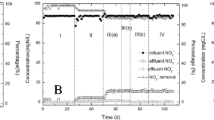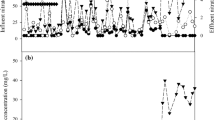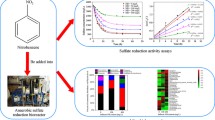Abstract
Denitrifying sulfide removal (DSR) process comprising both heterotrophic and autotrophic denitrifiers can simultaneously convert nitrate, sulfide, and acetate into nitrogen gas, elemental sulfur (S0), and carbon dioxide, respectively. Sulfide- and nitrate-laden wastewaters at 2–35 g/L NaCl were treated by DSR process. A C/N ratio of 3:1 was proposed to maintain high S0 conversion rate. The granular sludge with a compact structure and smooth outer surface was formed. The microbial communities of DSR consortium via high-throughput sequencing method suggested that salinity shifts the predominating heterotrophic denitrifiers at <10 g/L NaCl to autotrophic denitrifiers at >10 g/L NaCl.





Similar content being viewed by others
References
APHA (1998) Standard Methods for the Examination of Water and Wastewater, 20th edition. American Public Health Association, Washington, DC
Beristain-Cardoso R, Texier AC, Sierra-Alvarea R, Razo-Flore EJ, Field A, Gomez J (2009) Effect of initial sulfide concentration on sulfide and phenol oxidation under denitrifying conditions. Chemosphere 74:200–205
Chen C, Wang AJ, Ren NQ, Kan HJ, Lee DJ (2008) Biological breakdown of denitrifying sulfide removal process in high-rate expanded granular bed reactor. Appl Microbiol Biotechnol 81:765–770
Chen C, Wang AJ, Ren NQ, Lee DJ, Lai JY (2009) High-rate denitrifying sulfide removal process in expanded granular sludge bed reactor. Bioresour Technol 100:2316–2319
Fontenot Q, Bonvillain C, Kilgen M, Boopathy R (2007) Effects of temperature, salinity, and carbon: nitrogen ratio on sequencing batch reactor treating shrimp aquaculture wastewater. Bioresour Technol 98:1700–1703
Ismail SB, La Parra de CJ, Temmink H, van Lier JB (2010) Extracellular polymeric substances (EPS) in upflow anaerobic sludge blanket (UASB) reactors operated under high salinity conditions. Water Res 44:1909–1917
Kargi F, Uygur A (1997) Biological treatment of saline wastewater in a rotating biodisc contactor by using halophilic organisms. Bioprocess Eng 17(2):81–85
Krieger B, Schwermer CU (2006) Diversity of nitrate-reducing and denitrifying bacteria in a marine aquaculture biofilter Proceedings of the 11th International Symposium on Microbial Ecology (ISME-11) International Society for Microbial Ecology
Lee DJ, Pan X, Wang A, Ho KL (2013a) Facultative autotrophic denitrifiers in denitrifying sulfide removal granules. Bioresour Technol 132:356–360
Lee DJ, Wong BT, Adav SS (2013b) Azoarcus taiwanensis sp. nov., a denitrifying species isolated from a hot spring. Appl Microbiol and Biotechnol, 1-7
Laguna A, Ouattara A, Gonzalez RO, Baron O, Famá G, El MR, Guiot S, Monroy O, Macarie H (1999) A simple and low cost technique for determining the granulometry of upflow anaerobic sludge blanket reactor sludge. Water Sci Technol 40:1–8
Lefebvre O, Quentin S, Torrijos M, Godon JJ, Delgenes JP, Moletta R (2007) Impact of increasing NaCl concentrations on the performance and community composition of two anaerobic reactors. Appl Microbiol Biotechnol 75(1):61–69
Li W, Zhao QL, Liu H (2009) Sulfide removal by simultaneous autotrophic and heterotrophic desulfurization-denitrification process. J Hazard Mater 162:848–853
Liu M, Liu T, Peng Y, Wang S, Xiao H (2014) Effect of salinity on N2O production during shortcut biological nitrogen removal from landfill leachate. J Biosci Bioeng 117(5):582–590
Mahmood Q, Hu BL, Cai J, Zheng P, Azim MR, Jilani G, Islam E (2009) Isolation of Ochrobactrum sp. QZ2 from sulfide and nitrite treatment system. J Hazard Mater 16:5558–5565
Morgan JW, Forster CF, Evison L (1990) A comparative-study of the nature of biopolymers extracted from anaerobic and activated sludges. Water Res 24(6):743–750
Omil F, Mendez R, Lema JM (1995) Anaerobic treatment of saline wastewaters under high sulphide and ammonia content. Bioresour Technol 54(3):269–278
Osaka T, Yoshie S, Tsuneda S, Hirata A, Iwami N, Inamori Y (2006) Identification of acetate- or methanol-assimilating bacteria under nitrate-reducing conditions by stable-isotope probing. Microb Ecol 52(2):253–266
Paulina K (1969) The effect of some salts on Thiobacillus thioparus. Can J Microbiol 15(3):314–318
Reyes-Avila JS, Razo-Flores E, Gomez J (2004) Simultaneous biological removal of nitrogen, carbon and sulfur by denitrification. Water Res 38:3313–3321
Rinzema A, Vanlier J, Lettinga G (1988) Sodium inhibition of acetoclastic methanogens in granular sludge from a UASB reactor. Enzyme Microbiol Technol 10(1):24–32
Sun X, Wang H, Sun Y, Yu D (2010) Experimental study on shortcut nitrification of sewage from flushing toilet with seawater. J Environ Technol Eng 3(1):20–23
Teixeira C, Magalhaes C, Joye SB, Bordalo AA (2013) The role of salinity in shaping dissolved inorganic nitrogen and N2O dynamics in estuarine sediment waterInterface. Mar Pollut Bull 66:225–229
Truper HG, Schlegel HG (1964) Sulfur metabolism of Thiorhodaceae. I. Quantitative measurements on growing cells of Chromatium okenii. Anton Leeuw Int 30:225–238
Wang AJ, Liu CS, Han HJ, Ren NQ, Lee DJ (2009) Modeling denitrifying sulfide removal process using artificial neural networks. J Hazard Mater 168:1274–1279
Wang Q, Jiang G, Ye L, Pijuan M, Yuan Z (2014) Heterotrophic denitrification palys an important role in N2O production from nitritation reactors treating anaerobic sludge digestion liquor. Water Res 62:202–210
Wong B, Lee DJ (2011) Denitrifying sulfide removal and carbon methanogenesis in a mesophilic, methanogenic culture. Bioresour Technol 102:6673–6679
Acknowledgments
The research was supported by National Natural Science Foundation of China under Grant No. 21307160, Natural Science Foundation of Shandong Province under Grant No. ZR2013EEQ030 and Fundamental Research Funds for the Central Universities under Grant No. R1404005A. Thanks to Dr. Weimin Wu from Sanford for his help and suggestion in conducting this experiment.
Author information
Authors and Affiliations
Corresponding authors
Rights and permissions
About this article
Cite this article
Liu, C., Zhao, C., Wang, A. et al. Denitrifying sulfide removal process on high-salinity wastewaters. Appl Microbiol Biotechnol 99, 6463–6469 (2015). https://doi.org/10.1007/s00253-015-6505-5
Received:
Revised:
Accepted:
Published:
Issue Date:
DOI: https://doi.org/10.1007/s00253-015-6505-5




